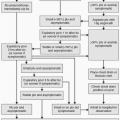Introduction
1. Abdominal aortic aneurysm (
AAA)—Definition:
a. An increase in diameter of 50% compared to the adjacent normal aortic segment, or
b. Sac diameter greater than 3 cm
2. Aneurysms are classified:
a. Morphologically: fusiform—affecting the entire arterial circumference, or saccular—affecting only part of the arterial circumference
b. By their relationship to the renal arteries: suprarenal, juxtarenal, or infrarenal
3. Associations include increasing age, male sex, smoking, coronary artery disease, hypercholesterolemia, peripheral vascular disease, hypertension, and family history (higher incidence in first-degree relatives). The reported prevalence ranges from 2% to 8% in adults older than the age of 65 years (
1,
2).
4. The natural history of
AAA is continuous expansion resulting in increased risk of rupture or distal embolization. Risk factors for
AAA rupture include aneurysm
size, rate of expansion, poorly controlled hypertension, chronic obstructive pulmonary disease (
COPD), smoking, and family history (
3). Most small aneurysms increase in size by 2.5 mm per year; 4 mm per year is maximum normal growth (
4). With progressive enlargement of an
AAA, there are also changes in the aorta above and below the aneurysm. The lengths of the proximal neck and distal cuff shorten, the entire aorta lengthens and becomes more tortuous, iliac tortuosity increases, and iliac aneurysms may form.
5. Ruptured
AAA is the 10th leading cause of death in men. The annual risk of rupture for
AAA (a) less than 5.5 cm: ≤1.0%, (b) 5.5 to 5.9 cm: 9.4%, (c) 6.0 to 6.9 cm: 10.2%, and (d) ≥7.0 cm: 32.5%. AAAs >5.5 cm have an annual risk of rupture exceeding the elective 30-day operative mortality; hence, this has been the size criterion for elective repair in men (
5,
6).
6. The ratio of men to women with
AAA is up to 6:1 (
7). Women have smaller aortic diameters compared to men, and a 5.5-cm
AAA represents a much larger relative dilatation and has an increased risk of rupture. Thus, some experts have recommended elective repair at 5 cm in women (
3).
7. Treatment of AAAs include endovascular aortic aneurysm repair (
EVAR) and open surgical repair. The perioperative 30-day mortality rate for
EVAR is significantly lower than for open repair. However, the 1-year mortality rates are similar between the two treatments (
3). At present, more than 70% of AAAs are treated via endovascular repair (
2). There are currently eight FDA-approved
EVAR devices (see
Table 18.1).
Goals of Stent-Graft Therapy
1. To provide a less invasive alternative for low-risk patients, lower procedural morbidity and mortality, decreased postprocedure pain, complications, and shortened convalescence
2. To provide treatment to high-risk patients who are not surgical candidates and would otherwise have no therapeutic option for
AAA repair







